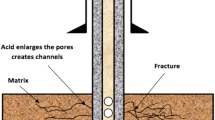Abstract
For the construction of the geological disposal system, the use of the cementitious material may affect the permeability change of the natural barrier around the repository. In practice, the construction requires a large amount of cement to maintain the mechanical stability of the repository system, particularly in Japan. Since such material alters the pH of ground water to highly alkaline region, also the permeability change of natural barrier is one of the notable factors for the performance assessments of geological disposal system.
In the high pH region, the solubility of silicic acid is very high compared to that in the natural pH (around 8). Therefore, the highly alkaline groundwater would dissolve and alter a part of rock surface. Usui et al. (2005) reported that the change of the pore structure due to the chemical reaction is the key factor to consider the change of the permeability. Moreover, such a change of the pore structure was considered as the result of the spatial heterogeneity of chemical composition. Since such spatial heterogeneity exists also in the sedimentary rocks consisted of crystalline minerals such as quartz and feldspar, we need to examine natural rock, in order to obtain more reliable understanding about the change of permeability induced by the highly alkaline groundwater (plume).
In this study, as crystalline mineral, silica sand was packed in the column, and the effect of dissolution induced by the highly alkaline plume on the permeability-change was examined. The silica sand particles mainly consist of SiO2 partially including Al2O3, CaO, Na2O3, and K2O. The volumetric flow rate and the pressure difference between the inlet and outlet of the column were measured, and the permeability was calculated. At the same time, the concentration of elements in the fluid was measured by the ICP-AES.
The experimental result showed that permeability decreased gradually, although the silica sand was continuously dissolved in the column. The behavior of the permeability is considered to be the result from the rearrangement of the particles. In the column test using the silica sand as packed mineral, the flow-path seems to be clogged by the rearrangement of the particles rather than the increase of the pore between the particles.
Similar content being viewed by others
References
D. Savage, D. Noy, M. Mihara, Applied Geochemistry, 17, 207 (2002).
C.I. Steefel, P. C. Lichtner, Geochimica et Cosmochimica Acta., 58, 3595 (1994).
Y. Niibori, M. Kunita, O. Tochiyama, and T. Chida, J. Nucl. Sci. Technol., 37, 349 (2000).
W. Stumm, J. J. Morgan, Aquatic Chemistry, 3rd ed. (John Wiley & Sons, New York, 1996), p. 368.
H. Usui, Y. Niibori, K. Tanaka, O. Tochiyama, H. Mimura, Scientific Basis for Nuclear Waste Management XXVIII, edited by Hanchar J. M. and Stroes-Gascoyne S. and Browning L., Mat. Res. Soc. Symp. Proc., 824, 449 (2004).
H. Usui, Y. Niibori, O. Tochiyama, H. Mimura, Journal of contaminant hydrology, (in preparation).
B. R. Bickmore, K. L. Nagy, A. K. Gray, A.R. Brinkerhoff, Geochimica et Cosmochimica Acta, 70, 290–305 (2006).
Author information
Authors and Affiliations
Rights and permissions
About this article
Cite this article
Usui, H., Niibori, Y., Tochiyama, O. et al. Permeability Change of Crystalline Silicate Mineral-Packed Bed Column by Highly Alkaline Plume. MRS Online Proceedings Library 985, 1116 (2006). https://doi.org/10.1557/PROC-985-0985-NN11-16
Received:
Accepted:
Published:
DOI: https://doi.org/10.1557/PROC-985-0985-NN11-16




